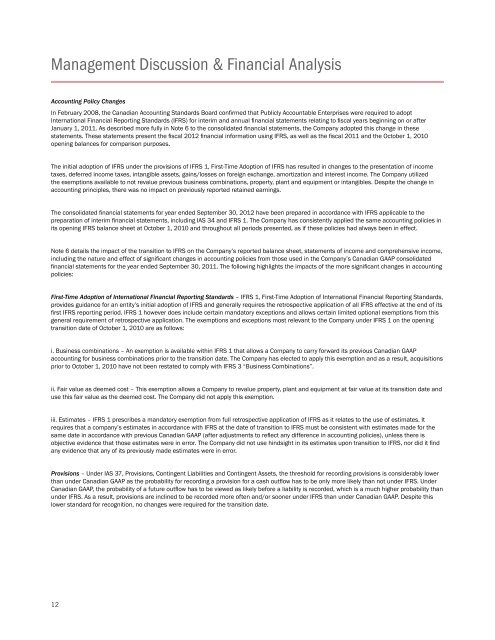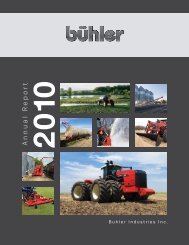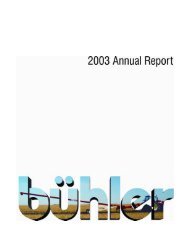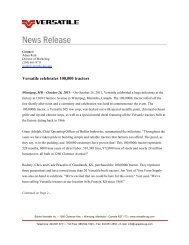complete financial statement - Buhler Industries Inc.
complete financial statement - Buhler Industries Inc.
complete financial statement - Buhler Industries Inc.
- No tags were found...
Create successful ePaper yourself
Turn your PDF publications into a flip-book with our unique Google optimized e-Paper software.
Management Discussion & Financial AnalysisAccounting Policy ChangesIn February 2008, the Canadian Accounting Standards Board confirmed that Publicly Accountable Enterprises were required to adoptInternational Financial Reporting Standards (IFRS) for interim and annual <strong>financial</strong> <strong>statement</strong>s relating to fiscal years beginning on or afterJanuary 1, 2011. As described more fully in Note 6 to the consolidated <strong>financial</strong> <strong>statement</strong>s, the Company adopted this change in these<strong>statement</strong>s. These <strong>statement</strong>s present the fiscal 2012 <strong>financial</strong> information using IFRS, as well as the fiscal 2011 and the October 1, 2010opening balances for comparison purposes.The initial adoption of IFRS under the provisions of IFRS 1, First-Time Adoption of IFRS has resulted in changes to the presentation of incometaxes, deferred income taxes, intangible assets, gains/losses on foreign exchange, amortization and interest income. The Company utilizedthe exemptions available to not revalue previous business combinations, property, plant and equipment or intangibles. Despite the change inaccounting principles, there was no impact on previously reported retained earnings.The consolidated <strong>financial</strong> <strong>statement</strong>s for year ended September 30, 2012 have been prepared in accordance with IFRS applicable to thepreparation of interim <strong>financial</strong> <strong>statement</strong>s, including IAS 34 and IFRS 1. The Company has consistently applied the same accounting policies inits opening IFRS balance sheet at October 1, 2010 and throughout all periods presented, as if these policies had always been in effect.Note 6 details the impact of the transition to IFRS on the Company’s reported balance sheet, <strong>statement</strong>s of income and comprehensive income,including the nature and effect of significant changes in accounting policies from those used in the Company’s Canadian GAAP consolidated<strong>financial</strong> <strong>statement</strong>s for the year ended September 30, 2011. The following highlights the impacts of the more significant changes in accountingpolicies:First-Time Adoption of International Financial Reporting Standards – IFRS 1, First-Time Adoption of International Financial Reporting Standards,provides guidance for an entity’s initial adoption of IFRS and generally requires the retrospective application of all IFRS effective at the end of itsfirst IFRS reporting period. IFRS 1 however does include certain mandatory exceptions and allows certain limited optional exemptions from thisgeneral requirement of retrospective application. The exemptions and exceptions most relevant to the Company under IFRS 1 on the openingtransition date of October 1, 2010 are as follows:i. Business combinations – An exemption is available within IFRS 1 that allows a Company to carry forward its previous Canadian GAAPaccounting for business combinations prior to the transition date. The Company has elected to apply this exemption and as a result, acquisitionsprior to October 1, 2010 have not been restated to comply with IFRS 3 “Business Combinations”.ii. Fair value as deemed cost – This exemption allows a Company to revalue property, plant and equipment at fair value at its transition date anduse this fair value as the deemed cost. The Company did not apply this exemption.iii. Estimates – IFRS 1 prescribes a mandatory exemption from full retrospective application of IFRS as it relates to the use of estimates. Itrequires that a company’s estimates in accordance with IFRS at the date of transition to IFRS must be consistent with estimates made for thesame date in accordance with previous Canadian GAAP (after adjustments to reflect any difference in accounting policies), unless there isobjective evidence that those estimates were in error. The Company did not use hindsight in its estimates upon transition to IFRS, nor did it findany evidence that any of its previously made estimates were in error.Provisions – Under IAS 37, Provisions, Contingent Liabilities and Contingent Assets, the threshold for recording provisions is considerably lowerthan under Canadian GAAP as the probability for recording a provision for a cash outflow has to be only more likely than not under IFRS. UnderCanadian GAAP, the probability of a future outflow has to be viewed as likely before a liability is recorded, which is a much higher probability thanunder IFRS. As a result, provisions are inclined to be recorded more often and/or sooner under IFRS than under Canadian GAAP. Despite thislower standard for recognition, no changes were required for the transition date.12





